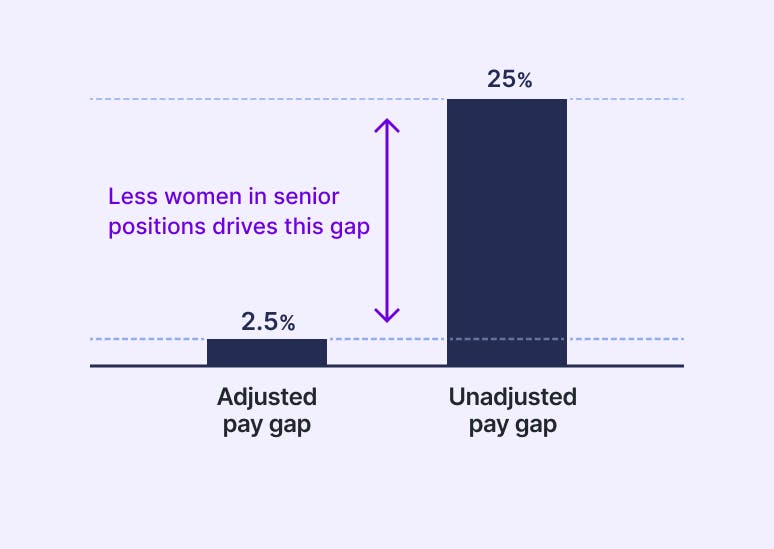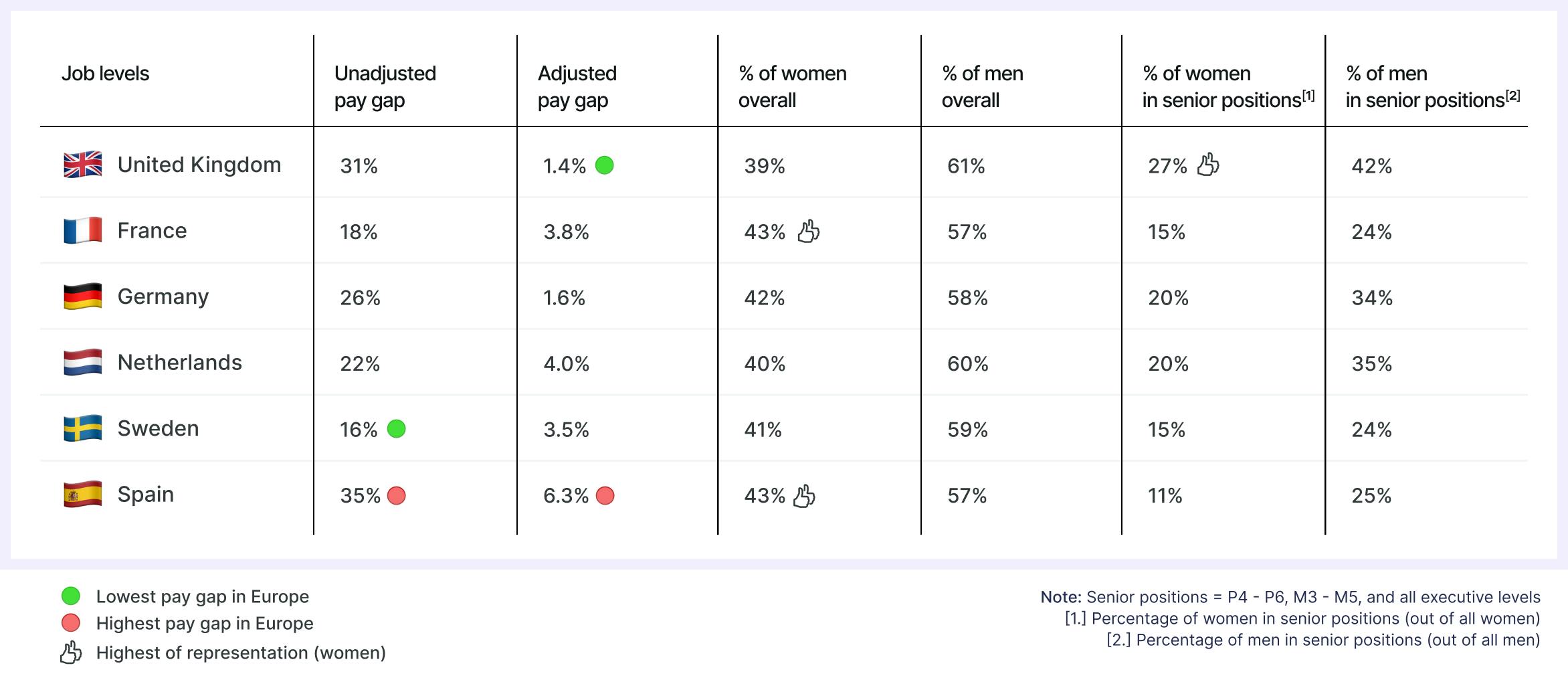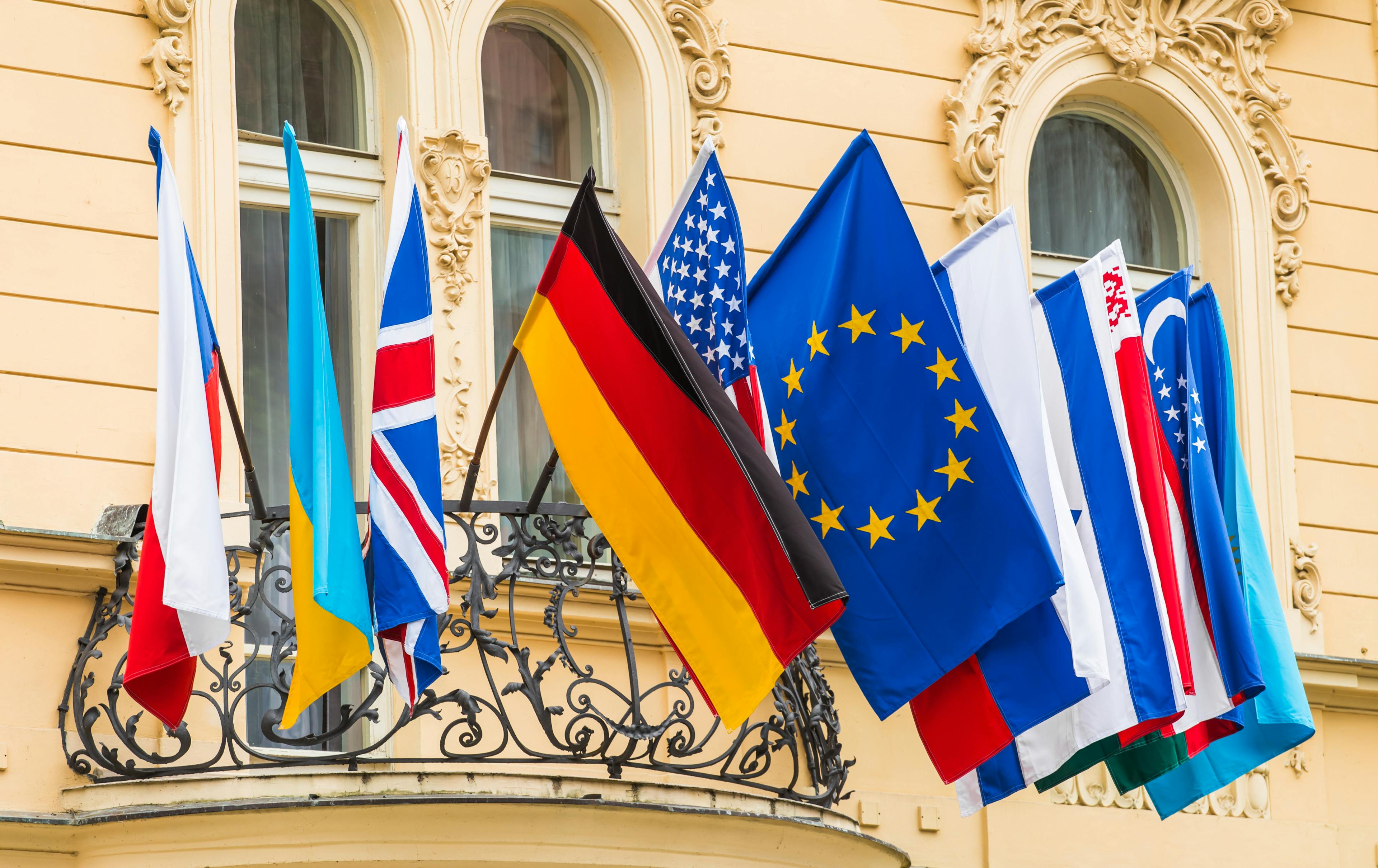While progress is being made, there’s still a ton of work to do when it comes to achieving pay equity and gender equality – a fact that is especially true within the world of work.
According to Ravio’s new pay equity report, women working in the European tech industry still earn 25% (median, unadjusted) less than men without considering external factors such as role, job level, and country, and 2.5% (median, adjusted) less than men after accounting for these factors (i.e. on a like-for-like basis).
While 2.5% might not sound like a lot, it is still a notable gap. It’s also an aggregate metric – to go even more granular, we must look at the pay gap by country, job function, and job level (based on our levelling framework). Through this lens, we can see that there is significant variance across each of these factors, highlighting poor performing functions or problematic levels, where women are paid far less compared to men than the above percentage indicates.
The difference between the adjusted and unadjusted gender pay gap also underscores a huge – and somewhat hidden – problem in European tech companies today: there is a critical lack of women across the board, but especially at senior positions earning higher salaries.
In this blog post, we’ll look at how pay equity varies across Europe and the impact of the lower representation of women in senior positions.

Subscribe to our newsletter for a monthly treasure trove of insights from Ravio's compensation dataset and network of Rewards experts, to help you navigate a career in compensation 📩
What does Europe's gender pay gap look like?
Across every country that Ravio analysed in Europe, there were two consistent themes:
- There is a consistent gender pay gap between men and women
- Women hold significantly fewer senior positions relative to their overall representation than men.
In both of these areas, Europe has much room to improve. The gender pay gap can be measured in one of two ways: unadjusted and adjusted.
What’s the difference between unadjusted and adjusted pay gaps, and why do we measure both?
We measure both the unadjusted pay gap and the adjusted pay gap to understand both the birds-eye view and the more nuanced like-for-like perspective.
- Unadjusted pay gap: The raw difference in median earnings between men and women without accounting for any factors such as job level, job position, and the country they perform their work in. It takes the median average of all men and women to offer a birds-eye view of pay equity.

- Adjusted pay gap: The adjusted pay gap takes into account factors that contribute to pay differences between men and women, including job position, job level, and country. ‘Adjusting’ the raw data to account for these things helps us paint a like-for-like comparison, which helps to assess whether men and women are receiving equal pay for equal work.

How does each country compare when it comes to the gender pay gap across Europe?
In Ravio’s pay equity report, female representation – both overall and in senior positions – was lower than that of men across every country. The fewer women there are in higher-paying, senior roles compared to men, the lower the median earnings of women and the higher the unadjusted pay gap.

Pay equity in the United Kingdom
While the UK has the lowest adjusted gender pay gap across Europe, its unadjusted pay gap sits at 31%, one of the highest. Only Spain has a higher unadjusted pay gap than the UK.
The main driver of the UK’s 31% pay gap is representation.
Despite London being one of the world's largest tech hubs, women only make up 39% of the workforce in the tech industry in the UK compared to men at 61%. What’s more, only 27% of those women are in senior positions, compared to 42% of men. While this is the highest – by far – amount of women in senior positions compared to other countries, much of the UK’s unadjusted pay gap can be explained by this difference.
Why are there less women in tech in the UK?
Ravio survey data tells us that 38% of women are put off by tech as an industry because societal perception indicates that it’s still a male space. It’s unsurprising - with men still making up the majority of the workforce at 59%, it’s no wonder 31% of women state they are actively reluctant to enter the European tech industry because of this perception.
Based on our findings, UK tech companies still need to do more in order to improve the representation of women, especially on the more senior side of the spectrum. This could have a positive domino effect for women: by creating more senior role models for women at the very beginning of their career, the more women would feel encouraged to enter the UK tech industry.
Pay equity in Germany
Germany is also doing comparatively well when it comes to the adjusted gender pay gap. Unlike other countries, Germany has a low adjusted gender pay gap in typically male-dominated functions like Engineering, which only had a 1.8% gap at the manager level.
However, Germany’s unadjusted gender pay gap sits at 26%, one of the highest in Europe. Like the UK, this can be partly attributed to representation.
While women make up 42% of the German tech workforce compared to 58% of men, only 20% of women are in senior positions. It means the majority of women are sitting in lower paid, junior levels. This might indicate that women are finding it difficult to climb the career ladder in German tech companies.
According to Maria Kamischke, VP of People & Culture at Lingoda GmbH, men are more pushy than women when it comes to salary negotiations – a trait instilled from early years.
“While the low adjusted pay gap in Germany shows we’re making progress, the high unadjusted pay gap is a direct consequence of the number of women decreasing as they climb the ranks. Women are still not considered equally for internal career progression in German tech companies compared to men, perhaps because they are less pushy and more humble – a mindset instilled from how women are being socialised from a young age.”
Maria Kamischke, VP of People & Culture at Lingoda GmbH
Legislation is changing the mindset towards pay equity. While the EU Pay Transparency Directive is coming into force for all European companies soon, Germany’s low adjusted pay gap could be attributed to Germany’s strong equal pay legislation: the Transparency in Wage Structures Act that was enforced in 2017.
“While legislation like the Pay Transparency Act helps to cure the symptoms of pay equity, it doesn't address the root cause. Companies must also adopt fair and strategic pay policies, driven by compensation systems and reliable data.”
Pay equity in France
Compared to the UK and Germany, France has a lower unadjusted gender pay gap. While this could usually be attributed to a high percentage of women in senior positions, for France that’s actually not the case.
France has one of the highest rates of women in tech across Europe – almost half. However, only 15% of these women are in senior positions. What contributes to France’s low unadjusted pay gap is also the smaller proportion of men in senior positions (24%) compared to women.
France was voted the fastest rising country in the tech space in 2023, growing its headcount by x2.5 times since 2018. So why are there so few women (and men, comparatively) in senior positions in tech?
One theory could be that France is simply later to the growth game than other countries. In 2014, it only produced 5% of new $1B+ tech companies in Europe, while last year that figure rose to 12%.
Unfortunately, France also has one of the highest adjusted gender pay gaps. This means that, while there are less women and men in senior positions, men are still getting paid 3.8% more than women for doing the same role. This is effectively making women work for nearly two weeks per year for free compared to their male counterparts performing the same job.
Pay equity in The Netherlands
The Netherlands has one of the highest adjusted gender pay gaps throughout Europe. It means women are paid less than men for doing the same role compared to all other countries analysed.
So why is The Netherlands falling behind when it comes to paying women equally for the same job as men? It’s difficult to say, but Ravio data suggests that the problem might be originating from certain functions.
When we dig in, Ravio data shows that the Finance function in Dutch tech has a much higher adjusted gender pay gap, at 10%, than other functions. This means that women working in finance in tech companies throughout The Netherlands earn roughly 10% less than men for doing the same job.
This could be a result of men entering the finance sector in Dutch tech negotiating higher salaries than women. Ravio data found that women and men receive similar rates of promotion and promotion-based pay increases, and so where there is a gender pay gap present, it’s usually introduced at the point of hire.
“Men are often said to negotiate more than women, and perhaps companies also allow men more room for manoeuvre. That is why a clear reward philosophy, reliable data and guidelines regarding equal pay are so important. Otherwise, skewed growth will occur.”
Pay equity in Sweden
It’s commonly suggested that the Nordics have better equality measures in place than other countries around the world. But Ravio’s data shows that while Sweden is leading in some areas, it isn’t coming out on top across the board.
Sweden has an unadjusted gender pay gap of 16%, which is the lowest across Europe. This is down to Sweden’s positive representation figures.
With 41% of women in Swedish tech, 15% of those are in senior positions. Men on the other hand represent only 24% of senior positions. The gap of 9pp between men and women is what keeps Sweden’s unadjusted rate low.
Women also appear to find it easier to enter the Swedish tech market – a result of many different factors, including culture, education, and legislation.
However, it’s important to note that Sweden does have significant room to improve. Sweden’s adjusted pay gap sits higher than other countries in Europe at 3.4%, meaning that women are effectively not being paid for around 12 days a year compared to men.
In July 2024 Sweden was the first EU member state to share a proposal for how they will implement the EU Pay Transparency Directive into Swedish law, and their plans suggest they will go above and beyond the required rulings – so it's clear they're serious about making those improvements.
"Sweden's impressive gender equality stats aren't by chance. It's a mix of strong cultural leanings towards fairness, smart government policies like shared parental leave, and an education system that pushes gender equality from the get-go. Swedish companies also deserve a nod; they're big on diversity and making sure everyone gets a fair shot. Plus, practical measures like affordable childcare make a huge difference."
Achieving gender pay equity and balanced representation in senior positions across Europe remains a significant challenge. The data from Ravio's report highlights persistent gaps and disparities that demand attention and action. It's clear that the lack of women in higher-paying roles is a major driver of the unadjusted pay gap, while the adjusted pay gap underscores ongoing inequities even for those in similar roles.
Curious to learn more about the gender pay gap in Europe and how your country measures up? Speak to our team or download our comprehensive pay equity report today and join the movement towards a fairer and more equitable workplace for everyone.



